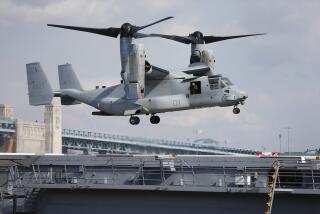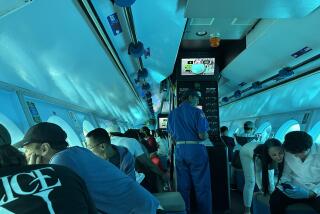Despite Sub Probe, Military Quietly Revives VIP Tours
WASHINGTON — Five weeks after a U.S. submarine struck and sank a Japanese trawler off Hawaii, the presence of 16 civilian VIPs on the craft remains a point of controversy and a focus of an official Navy investigation.
But on Monday, a group of freshmen lawmakers from the U.S. House will climb aboard a sub in Florida’s Port Everglades for eight hours of instruction and excitement--just the sort of thing that had been planned for visitors on the sub Greeneville before its deadly Feb. 9 collision.
The Distinguished Visitors Program has quietly come back because--bad publicity or no--it’s simply too important to the military to give up.
Because the sub accident raised questions about whether visitors hampered the crew’s work, VIPs can no longer take hold of the controls on Navy subs or Air Force fighter jets, nor fire Army howitzers or the cannons on M1A1 tanks. But they can do almost everything else that they used to be able to do on military tours, and the brass would like to see that they do.
Ever since President Lincoln instructed the Army of the Potomac to march through the center of towns “to show the country its Army,” the military has used such contacts to win moral support from the civilians who send it their tax dollars, and their sons and daughters.
These contacts have become especially important as the end of the military draft and the end of the Cold War have reduced the share of Americans who have served in the military.
“It’s important that people see what we’re doing, so we can continue doing it,” said Lt. Col. Bill Wheelehan, an Army spokesman.
Such contacts are valuable, too, at a time of jockeying among the services over procurement dollars and future missions. They know that visitors who have been awed by the power of a $1-billion attack sub are likely to be more receptive to arguments that the Navy needs more of them, not fewer.
In the aftermath of the accident, Defense Secretary Donald H. Rumsfeld began a study of civilian visits, and he ordered the services not to let visitors handle the controls of any piece of equipment when that operation “could cause increased safety risk.”
After reviews of the rules within the services, the Navy has ordered that while visitors are aboard, submarines can no longer conduct the kind of emergency surfacing drills that led the Greeneville to slice through the trawler Ehime Maru.
The Air Force has decided that visitors in two-seater fighter planes can no longer hold the joystick, as they used to do, while the pilot actually kept control with a separate joystick.
And the Army has decided that visitors can’t fire large “crew-served” weapons, such as tanks, howitzers or .50-caliber machine guns. Nor can visitors sit in the cockpits of tankers or cargo planes. Nonetheless, the visits have begun again, at nearly their former pace.
Trips Used to Train Crews, Navy Says
The Navy’s Pacific Fleet has authorized four submarine visits since the Greeneville accident. These include trips by community leaders, press and U.S. senators on Thursday and Friday on the attack submarine Helena, embarking from San Diego. The Navy says that these trips are not solely for public relations, that they hold some training value for the crews.
The three admirals sitting on the court of inquiry into the Greeneville collision all said, during introductory remarks, that they support the distinguished visitors public relations program as an invaluable way to influence public opinion in favor of the Navy.
But Vice Adm. John B. Nathman, who is presiding over the court of inquiry, said he thought the program had occasionally slipped into providing rides on ships as a reward for Navy boosters rather than as a way to influence important opinion-makers in the civilian community.
Rear Adm. Al Konetzni, head of the Pacific Fleet’s submarine force, testified that it was against Navy policy to send a ship to sea exclusively to show off for civilians, which happened with the Greeneville. On Friday, the three admirals sitting as the court of inquiry severely criticized a lieutenant commander in the public affairs office of the submarine fleet for having arranged the VIP cruise at the request of a retired admiral.
Military officials say they don’t have overall numbers for VIP visits, because they are approved and carried out at the discretion of local commanders.
But the Pacific Fleet in the last two years has taken 25,000 civilians, including journalists, aboard its ships for cruises that last anywhere from a few hours to overnight.
Such cruises are also popular with people living in Pacific Rim countries where U.S. ships make port calls or are home-based. In fact, 2,000 Japanese nationals last year were taken aboard U.S. ships, including several dozen who rode aboard submarines.
The trip planned Monday for first-term members of the U.S. House was organized by Rep. Edward L. Schrock (R-Va.), who is a retired Navy captain and president of the Republican freshman class.
Schrock, a member of the House Armed Services Committee, invited Democrats as well as Republicans, telling them that the trip represented “an extraordinary opportunity.”
In 1999, Tipper Gore, wife of then-Vice President Al Gore, christened the Greeneville and took a ride on the sub.
The tour programs have made a special effort to reach civilian “opinion leaders”--elected officials, community group officers, educators, celebrities and journalists--who can convey word about the programs to the public.
VIP Tours Began After World War II
Because of the way population growth has brought once-isolated bases into conflict with their neighbors over military traffic, noise and pollution, it has become especially important for commanders to stay on good terms with mayors and community groups.
James Forrestal, who was secretary of Defense after World War II, became concerned that with the massive demobilization of the late 1940s, the public would lose touch with the military.
He set up a program that each spring exposed 60 civilian leaders to military life. The program, which continues today, is considered the crown jewel of VIP tours. It received some unexpected publicity when a staff aide, onetime White House secretary Linda Tripp, became a principal figure in President Clinton’s sex scandal.
Just in the last few years, top Pentagon officials have become increasingly concerned about what they see as the widening gap between the civilian and military worlds. If that gap continues to grow, they say, civilians will increasingly shun military service and will resist military spending.
Bringing the two worlds together was one of the principal priorities of the last Defense secretary, William S. Cohen.
Military officials say they have always walked a fine line in trying to bring civilians close--but not too close--to dangerous military hardware.
Even during the Cold War, when the nuclear missile arsenal was on a higher level of operational alert, some VIP visitors could tour missile silos deep beneath the North Dakota prairie.
Some air bases in Europe allowed civilian visitors to go on self-guided tours--until they became aware that Europeans were drifting too close to buildings storing nuclear weaponry; the tours were discontinued.
Security on tours is an issue. Submarine commanders, for example, are supposed to see to it that secret controls and instrument panels are covered when visitors pass by.
And the Greeneville mishap is not the first time that a military accident occurred while civilians were along for a tour.
In 1981, an Air Force EC-135 tanker flying out of Wright-Patterson Air Force Base in Ohio crashed, killing 21. The flight was a “spouse incentive” ride for wives of Air Force crew members, and an investigation revealed that at least one spouse was in a pilot’s seat at the time of the accident.
The Air Force has since tightened the rules for such trips.
*
Times staff writer Tony Perry, in Pearl Harbor, Hawaii, contributed to this story.
More to Read
Sign up for The Wild
We’ll help you find the best places to hike, bike and run, as well as the perfect silent spots for meditation and yoga.
You may occasionally receive promotional content from the Los Angeles Times.







